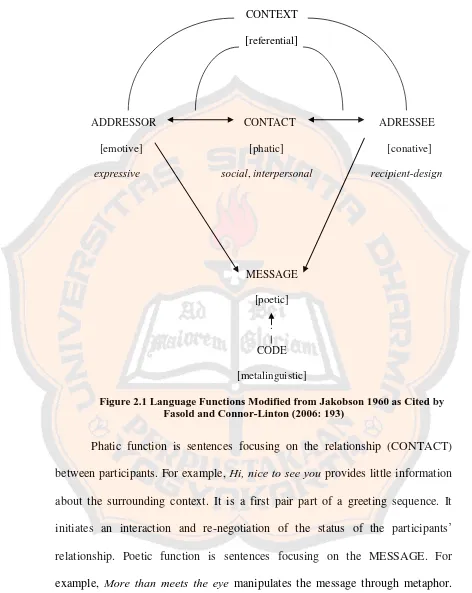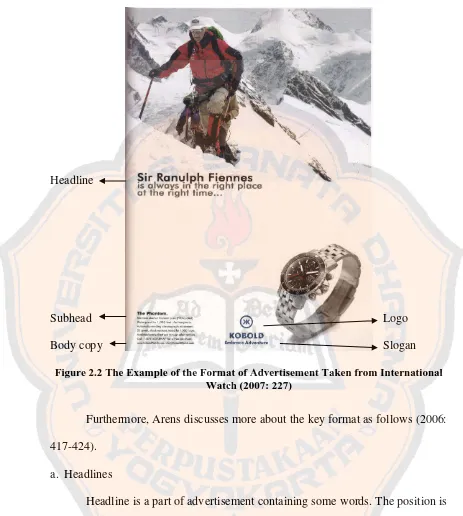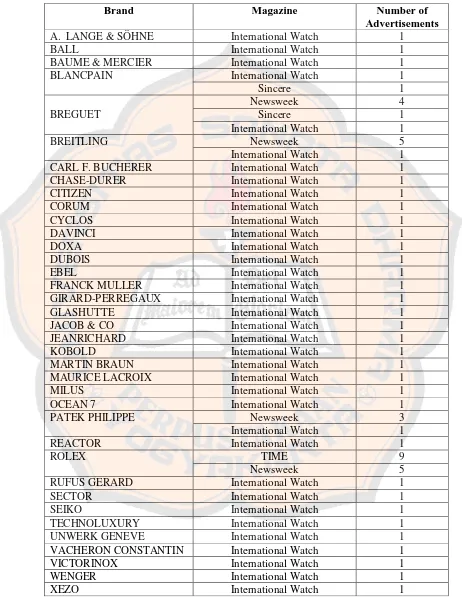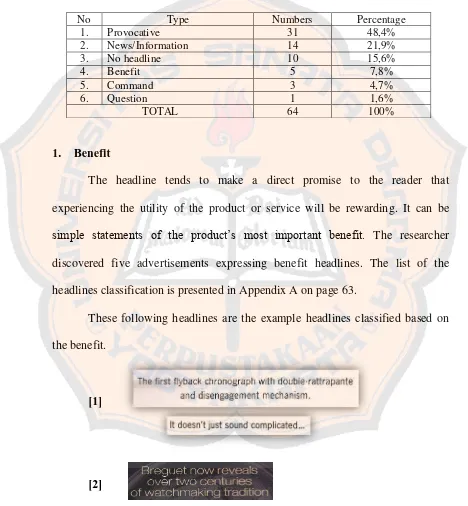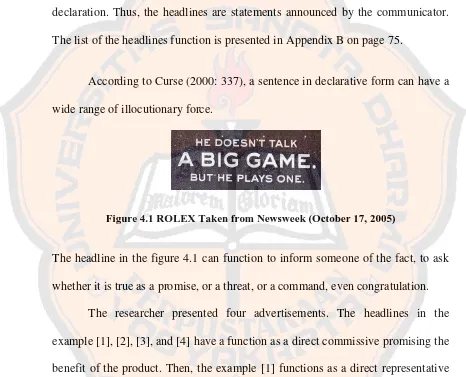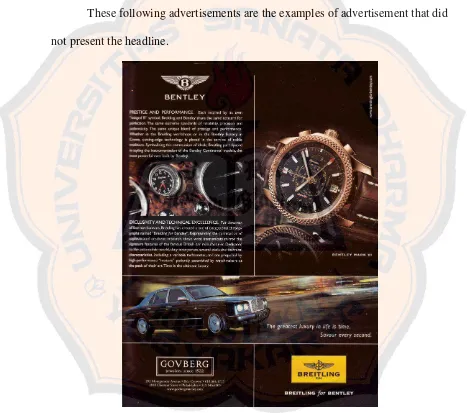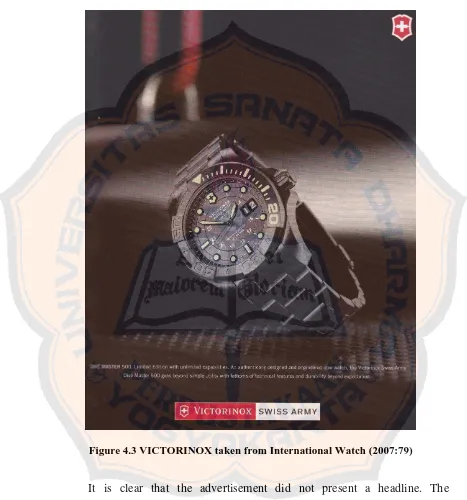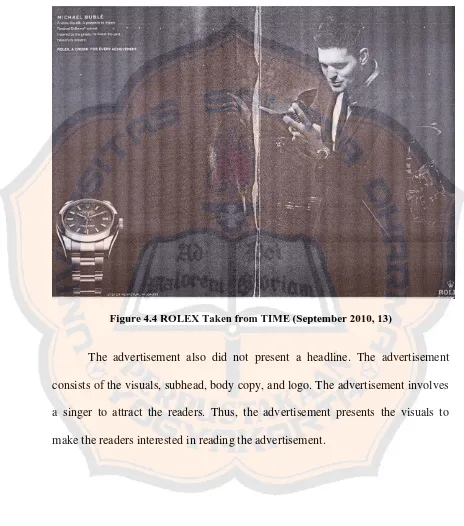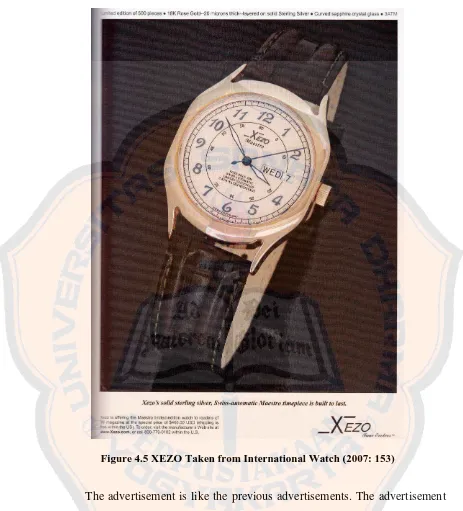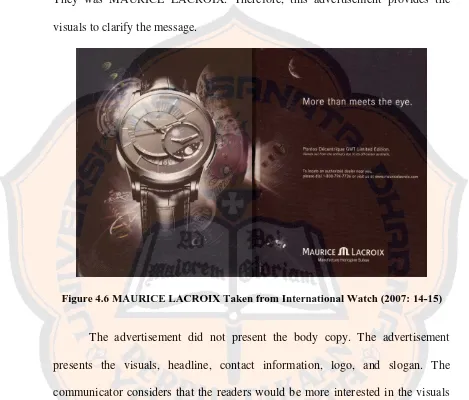A DISCOURSE ANALYSIS ON WATCH ADVERTISEMENTS
IN MAGAZINES
A THESIS
Presented as Partial Fulfillment of the Requirements to Obtain the Sarjana Pendidikan Degree
in English Language Education
By
Nurvitasari Kurniawati Student Number: 071214112
ENGLISH LANGUAGE EDUCATION STUDY PROGRAMME DEPARTMENT OF LANGUAGE AND ARTS EDUCATION FACULTY OF TEACHERS TRAINING AND EDUCATION
SANATA DHARMA UNIVERSITY YOGYAKARTA
i
A DISCOURSE ANALYSIS ON WATCH ADVERTISEMENTS
IN MAGAZINES
A THESIS
Presented as Partial Fulfillment of the Requirements to Obtain the Sarjana Pendidikan Degree
in English Language Education
By
Nurvitasari Kurniawati Student Number: 071214112
ENGLISH LANGUAGE EDUCATION STUDY PROGRAMME DEPARTMENT OF LANGUAGE AND ARTS EDUCATION FACULTY OF TEACHERS TRAINING AND EDUCATION
SANATA DHARMA UNIVERSITY YOGYAKARTA
iv
Dedicated to:
vii
ABSTRACT
Kurniawati, Nurvitasari. 2011. A Discourse Analysis on Watch Advertisements in Magazines. Undergraduate Thesis. Yogyakarta: English Education Study Programme, Department of Language and Arts Education, Faculty of Teachers Training and Education, Sanata Dharma University.
Advertisement is a medium which helps companies to promote their products. As media to persuade people, advertisements employ persuasive language. The persuasive language can affect the people’s perception buying a product. The researcher conducted a research on the advertising language used in watch advertisements. Watch advertisements are one of product advertisements found in media. People often find more watch advertisements in magazines than any other media. Watch advertisements are not complex to describe. Watch advertisements have the characteristics embodied in their linguistic features. This research aims to find out (1) the persuasive language expressed in the headline; (2) types of text used in the body copy.
This research used a discourse analysis. The researcher conducted on the language use of watch advertisements from TIME, Newsweek, Sincere Fine Watches, and International Watch magazines. The method used in this research was document analysis. The data of this research were in the written or visuals materials. The researcher collected the data from magazines. Next, the advertisements were divided based on the type of advertisements. Finally, the researcher analyzed them based on Arens (2006), Anderson & Kathy (1997), Cutting (2002), and Widyatama (2005) theories.
The result of this research showed that the success of the advertisement depends on the content and the function of headline. There were five types of headline. They are benefit, news/information, provocative, command, and question. The researcher also found that the headline had functions more than a mere statement or a declaration. There were some advertisements that employ the same pattern to express the persuasive language in the headline. The result also showed that there were three text types of body copy. They were explanation, information report, and exposition. Information report was often used in the advertisements. Moreover, this research found other findings. There were some advertisements that did not present the headline or the body copy.
The advertisements could be one of the authentic material sources in teaching and learning process. In accordance with the view of functional text, the advertisements provide the examples of English language use, mainly the persuasive language. Furthermore, some emotive words were employed in the advertisements to persuade the readers.
viii
ABSTRAK
Kurniawati, Nurvitasari. 2011. A Discourse Analysis on Watch Advertisements in Magazines. Skripsi Sarjana Pendidikan. Yogyakarta: Program Studi Pendidikan Bahasa Inggris, Jurusan Pendidikan Bahasa dan Seni, Fakultas Keguruan dan Ilmu Pendidikan, Universitas Sanata Dharma.
Iklan adalah sebuah media yang membantu perusahaan-perusahaan untuk mempromosikan produk-produk mereka. Sebagai media untuk mempengaruhi masyarakat, iklan memuat bahasa persuasif. Bahasa persuasif tersebut mampu mempengaruhi persepsi masyarakat dalam membeli sebuah produk. Peneliti melakukan sebuah penelitian mengenai bahasa iklan yang digunakan dalam iklan jam. Iklan jam adalah salah satu iklan barang yang ditemukan di media. Masyarakat sering menemukan banyak iklan jam di majalah daripada di media lain. Iklan jam tidak kompleks untuk didiskripsikan. Iklan jam mempunyai karakteristik-karakteristik yang terkandung dalam unsur-unsur linguistiknya. Penelitian ini bertujuan untuk mengetahui (1) bahasa persuasif yang diungkapkan dalam headline; (2) jenis teks yang digunakan dalam body copy.
Penelitian ini menggunakan analisis wacana. Peneliti meneliti penggunaan bahasa dalam iklan jam dari majalah TIME, Newsweek, Sincere Fine Watches, dan International Watch. Metode yang dipakai dalam skripsi ini adalah analisis dokumen. Data pada penelitian ini adalah materi-materi tertulis atau bergambar. Peneliti mengumpulkan data dari majalah. Kemudian, iklan-iklan tersebut berdasarkan jenis-jenis iklan. Akhirnya, peneliti menganalisa iklan-iklan tersebut berdasarkan teori-teori Arens (2006), Anderson & Kathy (1997), Cutting (2002), dan Widyatama (2005).
Hasil dari penelitian ini menunjukkan bahwa keberhasilan iklan bergantung pada isi dan fungsi dari headline. Terdapat lima jenis headline, yaitu benefit, news/information, provocative, command dan question. Peneliti juga menemukan bahwa headline mempunyai fungsi lebih dari sebuah pernyataan atau sebuah deklarasi belaka. Terdapat beberapa iklan menggunakan pola yang sama untuk mengungkapkan bahasa persuasif pada headline. Hasil penelitian juga menunjukkan bahwa terdapat tiga jenis teks yang digunakan pada body copy, yaitu explanation, information report, dan exposition. Information report adalah jenis teks yang sering digunakan dalam iklan tersebut. Sebagai tambahan pula, penelitian ini menemukan hasil yang lain. Terdapat beberapa iklan yang tidak menyertakan headline atau pun body copy.
Iklan-iklan tersebut dapat digunakan sebagai sebagai salah satu sumber materi autentik dalam proses belajar dan mengajar. Sehubungan adanya ragam bahasa sebagai teks fungsional, iklan-iklan tersebut dapat digunakan sebagai contoh penggunaan bahasa Inggris, terutama bahasa persuasif. Kata-kata emotif juga digunakan untuk mempengaruhi pembaca.
ix
ACKNOWLEDGEMENTS
First of all, I would like to express my deepest gratitude to Allah SWT for all His blessings and mercies, so I finally accomplished my thesis. It is only for Him I give all my hopes and wishes.
I realize that I could never have completed my thesis without the help of my sponsor, Carla Sih Prabandari, S.Pd., M.Hum., who has given her time and thought to read my thesis. I also thank her for her patience, guidance, generosity, encouragement for completing this thesis. To all my lecturers, I thank for their patience and dedication. They have enriched my knowledge in writing this thesis.
In addition, I would like to thank some people who support the completion of this thesis. I owe special thank to sister Margaret O’ Donohue, FCJ and
Chrysogonus Sidha Malilang, S.Pd., M.Phil. for checking my language. I thank Theresia Dewi Puspitasari, S.S. for her encouragement and sharing information. I also thank my beloved parents, Bapak Giyarno, S.Pd. and Ibu Sukini, S.Pd., for
their support and prayer. I thank my sister, Novi Dyah Kusumaningrum, for her
encouragement.
I would thank my friends in PBI, especially Yovita Felicia Hapsari,
Ligolita Putri Fathoni, Meilia Restyanty, Lucia Thisda, Christine
Permatasari, Lucyana Wirati, and Fransiska Debby Coryanti for their help,
attention, sharing life experiences, and togetherness.
Finally, I would like to express my special thanks to MAFIA group:
x
experiences. We have spent our weekends together for combating the stress. This friendship will never end.
Nurvitasari Kurniawati
xi
TABLE OF CONTENTS
Page
TITLE PAGE ………... i
APPROVAL PAGES ………... ii
DEDICATION ………. iv
STATEMENT OF WORK’S ORIGINALITY……… v
LEMBAR PERNYATAAN PERSETUJUAN PUBLIKASI KARYA ILMIAH UNTUK KEPENTINGAN AKADEMIS ……… vi
ABSTRACT ………. vii
ABSTRAK ………. viii
ACKNOWLEDGEMENTS ………. ix
TABLE OF CONTENTS ………. xi
LIST OF TABLES ………... xiv
LIST OF FIGURES ………. xv
LIST OF APPENDICES ……….. xvi
CHAPTER I. INTRODUCTION A. Research Background ……… 1
B. Problem Formulation ………. 4
C. Research Objectives ……….. 4
D. Research Benefits ……….. 4
E. Definition of Terms ………... 5
CHAPTER II. REVIEW OF RELATED LITERATURE A. Theoretical Description ………. 7
1. Language Functions ………. 7
2. Language of Advertisement ………. 11
xii
4. The Format of Advertisement ……….. 15
a. Headlines ………. 16
1) Benefit ……….. 17
2) News/Information ………. 17
3) Provocative ………... 17
4) Question ……….... 18
5) Command ……….. 18
b. Subheads ………... 18
c. Body Copy ………... 18
d. Slogans ………. 18
e. Seals, Logos, and Signatures ………... 19
5. Theory of Discourse Analysis ……….. 19
a. Discourse Analysis ……….. 19
b. Speech Acts ………... 20
c. Text and Context ………... 22
B. Theoretical Framework ………. 25
CHAPTER III. RESEARCH METHODOLOGY A. Research Method ………... 26
B. Research Subjects ………. 27
1. TIME ……… 29
2. Newsweek ……… 29
3. Sincere Fine Watches ………... 29
4. International Watch ……….. 29
C. Research Instruments ……… 30
D. Data Gathering Technique ……… 30
E. Data Analysis ……… 30
xiii
CHAPTER IV. RESEARCH FINDINGS AND DISCUSSION
A. The Expressions of Persuasive Language in Watch Advertisement
Headlines ………... 33
B. The Text Types of Watch Advertisement Body Copies ………… 45
C. Other Findings ………... 50
CHAPTER V. CONCLUSIONS, IMPLICATIONS, AND SUGGESTIONS A. Conclusions ………... 56
B. Implications ………... 57
C. Suggestions ………... 58
xiv
LIST OF TABLES
Table Page
3.1 The Number of Advertisements in Every Magazine ……… 28
xv
LIST OF FIGURES
Figure Page
2.1 Language Functions Modified from Jakobson 1960 as Cited by
Fasold and Connor-Linton ………... 9
2.2 The Example of the Format of Advertisement Taken from International Watch ………... 16
4.1 Rolex Taken from Newsweek ……….... 36
4.2Breitling Taken from International Watch ………. 51
4.3 Victorinox Taken from International Watch ……….. 52
4.4 Rolex Taken from TIME ……… 53
4.5 Xezo Taken from International Watch ………... 54
xvi
LIST OF APPENDICES
Page Appendix A : The List of the Advertisement Headlines based on
the Headline Types ……… 63 Appendix B :The List of the Advertisement Headlines based on
the Speech Acts ……….. 75 Appendix C :The List of the Advertisement Body Copies based on
the Text Types ………... 86 Appendix D : Sample Advertisements from the Magazines ……… 112 Appendix E : The Example of Advertisement as a Functional Text ………... 119
1
CHAPTER I
INTRODUCTION
This chapter discusses the background of the research, problem formulation, problem limitation, research objectives, research benefits, and definition of terms.
A. Research Background
Language is a system of communication to express thoughts. It is a mean to connect one person to another and thus having an important role in communication. By using language, we also communicate with each other and create a bridge for developing relationship with others. Fromkin, Rodman, and Hyams (2003: 4) explain that “When you know language, you can speak and be understood by others who know that language”.
Many people use language to communicate with others in many terms, including social, education, politics, entertainments, advertisements, etc. People can give information to each other. In a simple way, people can interact with each other through conversation. On the contrary, it is impossible to inform many people in different places in the world directly.
medium vehicle” (2003: 153). Starting from this context, it is assumed that language plays as the predominant means of communication in advertisements.
Goddard (1998: 2) explains that product manufacturers would not invest in advertisements if they did not work. It means that a company would advertise their product to get the response from the public. A company must pay attention to everything that will write in the advertisement. Therefore, advertisement is made in an attractive way in order to persuade people to buy the advertised product.
Since many products can be advertised, the selection of the media is important. As cited by Sutaryo (2005: 16), Hedebro Goran described that “The mass media can create a climate/or change by inducing new values, attitudes, and modes of behavior favorable to modernization”. It means that the mass media has an important role in social change. For example, the customer wants to buy a product because he or she is interested in the advertisement. Therefore, the company should focus on making advertisement with a view to all possibilities.
not limited to decide the figure of speech, language style, pictures, signs, and so on. The importance here is that the company should mix all of them to make a good advertisement so that the customers will be attracted.
This topic was chosen because the researcher observed the use of language in advertisement of a product affects the customers’ perception to buy the product. Every magazine has different language characteristics. The focus of the present research is to observe the watch advertisements in printed media, mainly magazines.
Watch advertisement is one of the products advertised in magazine. In the same way, watch has a simple function as a timer. People can also see more watch advertisements in magazines than in any other media. People will find many slogans or taglines of advertisements. For example, “Time is more than money”. This sentence means that time is more valuable than money. We depend on time to do everything. Moreover, the era is getting more modern and many companies compete in manufacturing watch models. It makes people interested in so that companies use mass media to advertise the product. Furthermore, marketing will be more successful if communication between communicator (companies) and society about the product existed. Advertising is the way to promote the product.
B. Problem Formulation
The researcher has formulated two problems covering all elements in discourse analysis. The problems of this research are formulated as follows. 1. How is the persuasive language expressed in watch advertisement headlines in
magazines?
2. What text types are used in watch advertisement body copies in magazines to give information about the product?
C. Research Objectives
Based on the problem formulation above, this research aims to solve those problems. The research aims to:
1. analyze the headlines expressed in the watch advertisements in magazines 2. identify the text types used in the body copy of watch advertisements in
magazines
D. Research Benefits
The researcher expects that this research will have the following benefits: 1. The Benefit for the Students
This research deals with language use in the advertisement. This research will enrich the students’ knowledge about advertising language, especially the
2. The Benefit for the Teachers
This research also gives contribution of the way of teaching persuasive language, especially in reading and writing. The result of this research presents the expressions of the persuasive language in the headline and text types in the body copies. The teachers are expected to develop the students’ communicative ability by using a discourse analysis.
3. The Benefit for the Future Researchers
The present researcher conducts on discourse analysis of watch advertisements. It aims to analyze the language use of watch advertisement. This research can be used as an additional reference to conduct the similar research.
E. Definition of Terms
To avoid misinterpretation and to have better understanding of this research, the researcher considers the importance of defining the terms used in this research. In this part, the researcher provides the explanation of special terms used in this research.
1. Watch Advertisement
2. Discourse Analysis
Discourse focuses on the use of language. Therefore, discourse analysis is the analysis of language use. It can be in spoken or written texts. Discourse is a unit of language above and beyond a mere accumulation of sounds, morphemes, words, clauses, and sentences (Fasolf & Jeff, 2006: 171).
3. Magazines
Magazines are one of printed media to convey message, including news, education, entertainment, health, and advertisement. The researcher used the watch advertisements taken from:
7
CHAPTER II
REVIEW OF RELATED LITERATURE
In this part, the researcher presents theories relevant to this research. The theories are taken from some books and journals about language, discourse analysis, advertisements, and communications.
A. Theoretical Description
To answer the problems mentioned in the problem formulations, the researcher will review some theories in order to find out which theories might be able to be used to answer those problems. From the problem formulations, the possible theories might be used are those on language functions, language of advertisement, structure of advertisements, the format of advertisement, and theory of discourse analysis.
1. Language Functions
There are many functions of language. Its main function is referential. It means that we use language to convey information about entities, such as people and objects. Language also has social and expressive function. Thus, people can use language to do things like thanking, boasting, insulting, and apologizing. Language also functions to convey to others how people feel. People use language to persuade others of our convictions and urge them toward action by writing texts that demonstrate the logic and appeal of those convictions.
As cited by Fasold and Connor-Linton (2006: 193), there is a model adapted and modified from Jakobson 1960 presents six functions of language (Figure 2.1 on page 9). This model represents the speech situation as a multidimensional set of relationships. There are different facets, different connections between the components of the speech situation, the features of language used, and the communicative function performed by that language. Each language function is related to a different facet of speech situation. It indicates the relationship between speech situation and language function.
Those six functions of language will be explained more in this following paragraph. The first function is referential function. Referential function is sentences focusing on aspects of the speech situation, such as the participant and the setting. CONTEXT influences ADDRESSOR‟S and ADDRESSEE‟S
CONTEXT
[referential]
ADDRESSOR CONTACT ADRESSEE
[emotive] [phatic] [conative]
expressive social, interpersonal recipient-design
MESSAGE
[poetic]
.
CODE
[metalinguistic]
Figure 2.1 Language Functions Modified from Jakobson 1960 as Cited by Fasold and Connor-Linton (2006: 193)
Emotive function is sentences expressing the impact of some facet of the context or feelings/senses on the ADDRESSOR. For example, I am hungry states feeling of the ADDRESSOR. It may be interpreted as a request that the ADDRESSEE makes dinner. It may also have a conative function. Conative function is sentences focusing on the relation of the ADDRESSEE to the context or the interaction. For example, Are you hungry? can be interpreted as either a request for information from the addressee or as an invitation to join the addressor for dinner. Metalinguistic function is sentences focusing on the code itself. This function deals with the language itself. For example, asking Did you just say “Don” or “Dawn” was coming? focuses on the English language.
Sentences typically serve more than one function at a time. Although a sentence may have a primary function, it is likely to be multifunctional. Jakobson‟s 1960 model of language functions stresses the context beyond the
sentence. The researcher agrees that language has many functions in writing and spoken language.
There are also many languages in the world and every language has characteristic. There are some factors influencing the characteristics, including vocabulary, style or expression of the speakers, and grammar. For example, every advertisement has its own characteristic. Every advertiser has different style or expression to deliver the message. Every advertisement also employs different vocabularies.
and Connor-Linton (2006: 173), Hymes (1974) mentioned that knowledge about how to use language in different speech situations, how to interact with different people engaged together in different events, and how to use language to perform different acts is called communicative competence.
2. Language of Advertisement
Advertising is a business in which language functions to persuade people to do and believe things. Everyone recognizes that advertisement persuades people to buy products. Therefore, the company has to create the text as attractive as possible. It is because advertisement has a main aim to build a good image of products. Therefore, the advertising language is very positive.
As cited by Kpolugbo and Richard (2006: 180) in an Encyclopedia of the Arts, Domel and Todd say “many aspects of the language (of advertisements)
contribute to the emotive power advertising language, the choice and order of words, the syntactic arrangement, the prestige of the speaker, the frequent appeals to authority”. It can be concluded that the language of advertisement is the major
factor contributing to the success of the advertisement as it has the power to move to action.
help the company to attract the customers. Sometimes, some advertisements also use figurative languages, such as personification, metaphor, hyperbole, and simile. For example, LIFE IS AN ADVENTURE. This kind of language will be memorable. It means that the advertising language helps the customers to remember better than the daily language.
Based on the explanation above, people can find the linguistic message in the advertisement. As cited by Kpolugbo and Richard (2006: 183), Domel and Todd identify three main factors in spoken or written advertising language. The first is the language of advertisement is simple based on colloquial speech. For example, Inspired and Inspiring (watch-REACTOR). This sentence is simple and easy to understand. The second is that the body copy of advertisement is written with colloquial impression which is belied on the parallelism. For example, Be
Past tense is also usually avoided. The reason is the products are in the present and presently available. For example, With a first-class engine in the world, it Justifies for you (motorcycle). There is no finite verbs occur in the all
advertisements. For example, Limited edition (watch). All advertisements use the imperative constructions, such as Ask for more (Pepsi). The use of verb forms implies a universal timeless, such as Never a dull moment with STAR (star beer). Sometimes past tenses are used in the advertisements. It stresses the long traditions associated with products or emphasizes reliability, such as No limitations attached. Therefore, there is the rule in writing advertisements.
3. Structure of Advertisements
Advertisement and advertising comes from Latin word, “advertere” means “turn towards” (Goddard, 2002: 9). Generally, advertisement is a commercial
communication to promote an organization and its products to the public, such as advertisement in television, radio, newspaper, magazine, etc.
Since the advertising language is used to promote an advertised product, it must be attractive. The company should also pay attention to other factors. They are the audience/readers, the format, the effect, etc.
According to Widyatama (2005: 17), there are six principles in advertisement. They are:
a. Message
Advertisement has a message to convey. There are two forms of message, verbal and non verbal. Verbal message is a message conveyed in spoken or written. Spoken verbal message can be conveyed through audio and audio visual while written message can be conveyed in printed media and audio visual. Non verbal message is in the form of pictures or signs.
b. Non personal
Based on the definitions of advertisement, advertisement is conveying message nonpersonally. This message is not conveyed directly, but this message is conveyed through advertising media, such as radio, television, film, poster, banner, leaflet, internet, and billboard.
c. Communicants
A communicator makes advertisement because a communicator wants to convey the message to certain communicants. A communicator has to pay attention to the communicants‟ need, interest, willing, characteristic, etc.
d. Payment
A communicator has to pay to convey the message of advertisement. The form of payment is not only money but also time, space, and opportunity. For example, a communicator wants to hold a seminar, but a communicator does not have enough money. A communicator will advertise in radio. A communicator can give the opportunity to the manager of the radio to attach the radio‟s logogram in the backdrop.
e. Effect
Every advertisement has a certain aim or a certain effect. It can be getting the money or building the good image. Considering the effect, a communicator should make an affective message. An effective message is a message which is able to describe what the communicator needs exactly and the communicants have the same interpretation with the communicator. The effective message is expected to give a certain effect to communicants.
4. The Format of Advertisement
Headline
Subhead Logo
[image:33.595.63.526.106.622.2]Body copy Slogan
Figure 2.2 The Example of the Format of Advertisement Taken from International Watch (2007: 227)
Furthermore, Arens discusses more about the key format as follows (2006: 417-424).
a. Headlines
These can increase readership and improve the boom factor of an advertisement. The words should be employed whenever honestly applicable. For examples, free, now, amazing, announcing, introducing, it‟s here, improved, at last, revolutionary,
just arrived, new, and important development.
There are many variations of headlines depending on the advertising strategy. Headlines may be classified by the type of information they carry. They are:
1) Benefit
The headline tends to make a direct promise to the readers. It is to promise the readers that experiencing the utility of the product or service will be rewarding. The headline can also be simple statements of the product‟s most important benefit.
2) News/Information
The headline provides news or promises information of the product. It can be a claim of the product.
3) Provocative
The headline is to provoke the readers‟ curiosity. The readers must read the body copy to learn more about the advertisement. The lack of the headline is the readers won‟t read on. Therefore, the headline provides visuals or some stories
4) Question
The headline asks a question and encourages the readers to search for the answer in the body copy of the advertisement. A good question headline builds the readers‟ curiosity and imagination.
5) Command
The headline tends to order the readers. It might seem negative, yet the readers pay attention to such headlines. The headline is able to motivate the readers through fear emotion.
b. Subheads
The subhead is an additional smaller headline that may appear above the headline or below it. A subhead above the headline is called a kicker (or over line) and may be underlined. Subheads may also appear in the body copy. Subheads are larger than body copy and usually in boldface, italic, or different colour. Most people read only the headline and subheads. Subheads usually support the interest step best.
c. Body copy
The body copy or text tells the complete sales story and comprises the interest, credibility, desire, and the action steps. Body copy also covers the features, benefits, and utility of the product or service. The best advertisements focus on one big idea or one clear benefit.
d. Slogans
advertisements in a campaign and to reduce an advertising message strategy to a brief, repeatable, and memorable positioning statement.
e. Seals, Logos, and Signatures
A seal is awarded only when a product meets standards established by a particular organization such as the Organic Crop Improvement Association and Parents Institute. Their seals provide an independent, valued endorsement for the advertiser‟s product.
Logotypes (logos) and signature cuts (sig cuts) are special designs of the advertiser‟s company or product name. They appear in all company
advertisements, give the product individuality and provide quick recognition at the point of purchase.
5. Theory of Discourse Analysis
Discourse analysis is one of branch linguistics focusing on how people use language in texts and contexts. As cited by Fasold & Connor-Linton (2006: 169), Deborah explained there are six functions using discourse. They are to represent the world, to convey communicative intentions, to organize thoughts into communicative actions, arrange information so it is accessible to others, to engage in actions and interactions with one another, and to convey their identities and relationships.
a. Discourse Analysis
involves ways of thinking about discourse and ways treating of discourse as data. Advertisement is one of discourses.
As cited by Wood & Rolf (2000: 3-4), Potter (1997) explained discourse analysis in general.
[Discourse analysis] has an analytic commitment to studying discourse as texts and talk in social practices. That is, the focus not on language as an abstract entity such as a lexicon and set of grammatical rules (in linguistics) … (p.146).
Based on the theory, it can be concluded that language is not merely as communication mean. Moreover, language has a function as social practices. It means language become a discourse as data.
Discourse analysis has recently been established as a new discipline, which draws from many different disciplines (linguistics, sociology, psychology, cultural worlds, and so forth). From the linguistics, advertisement as one of discourses cannot be separated from the language use. From the sociology, advertisement is to create a certain action and the communicative competence among individuals. From the psychology, advertisement aims to influence the motivation and behaviour of the society. Meanwhile, the cultural worlds can show how the culture has been developing.
b. Speech Acts
act. The locutionary act is analysis of the words which the speakers say or the act of saying something. The illocutionary act is what is done in uttering the words, the function of the words, the specific purpose which the speakers have in mind. For example, the speech acts promising, inviting, advising, ordering, excusing, and apologizing. The last is the effect on the receiver, the receiver‟s reaction or what is done by uttering the words. Moreover, performative hypothesis said that every utterance has a performative verb, such as to order, to warn, to admit and to promise. It makes the illocutionary force explicit.
As cited by Cutting (2002: 16-17), Searle (1976) has also classified the speech act in the following macro-class. They are declarations, representatives, commissives, directives, and expressives. Declarations are acts that change the world by their very utterance, such as I bet, I declare, I resign, I baptize. Representatives are acts in which the words state what the speaker believes to the case, such as describing, claiming, hypothesizing, insisting, and predicting. Commissives include acts in which the words commit the speaker to future action, such as promising, offering, threatening, refusing, vowing and volunteering. Directives aim at making the receiver do something, such as commanding, requesting, inviting, forbidding, suggesting, and so on. Expressives are acts in which the words state what the speaker feels, such as apologizing, praising, congratulating, deploring, and regretting.
Moreover, Sealer (1974: 18) says that
more than what he actually says, but it is always in principle possible for him to say exactly what he means.
It means that the receiver can catch the meaning based on the speaker‟s speech
acts performed. Therefore, the researcher will analyze the speech acts.
c. Text and Context
Discussing discourse analysis cannot be separated from text and context. Text is pieces of writing or spoken discourse. As cited by Titscher, Michael, Ruth, & Eva (2000: 21), de Beaugrande & Dressler defined a text as a communicative event. It means that text is one of media of discourse. In terms of utterance of words, text is the linguistic content: the stable semantic meanings of words, expressions, and sentences, but not the inferences available to receivers depending upon the contexts in which words, expressions, and sentences are used. It can be concluded that text learns about the meaning what the speakers said. On the contrary, context focuses on the environment the sayings occur.
Anderson & Kathy (1997: 1) has classified text type into two. They are literary and factual texts. Literary texts include movie scripts, limericks, fairy tales, plays, novels, song lyrics, mimes, and soap operas. Their aims are to entertain and make people think about their life or consider their beliefs. There are three main text types in the literary texts. They are narrative, poetic, and dramatic.
1. Recount
Speaking or writing about past events is called a recount (Anderson & Kathy, 1997: 48). The purpose of a recount is to give the audience a description of what occurred and when it occurred.
2. Response
Anderson & Kathy (1997: 6) say that the response text type is a person‟s response or action to another text (a book, film, play, poem, and so on). It gives a description of the work and a judgment.
3. Explanation
Speaking or writing about how or why things happen is called an explanation (Anderson & Kathy, 1997: 80). The explaining text type tells how or why something occurs. It looks at the steps rather than things. The purpose of an explanation is to tell each step of the process (the how) and to give reasons (the why).
4. Discussion
Discussion is speaking or writing about a topic and include both sides of the case (Anderson & Kathy, 1997: 116). The discussion text type gives the for and against, the positive and negative, or the good points and the bad points. The purpose of a discussion is to present to the audience different opinions on a topic and, at the end, the writer‟s opinion.
5. Information report
facts about the subject, a description and information on its part behaviour and qualities.
6. Exposition
An exposition is a piece of text that presents one side of an issue (Anderson & Kathy, 1997: 122). The purpose of an exposition text is to persuade the reader or listener by presenting one side of an argument.
7. Procedure
A procedure text is a piece of text that has function to instruct someone on how something can be done (Anderson & Kathy, 1997: 5). A procedure text is the text type that it does not include in the discussion. This text will not include in the analysis.
Speech act theory and pragmatics define context primarily as „knowledge‟.
It is also supported by Peccei and Yule‟s theory. As cited by Cutting (2002: 2),
Peccei and Yule explain that both pragmatics and discourse analysis study the meaning of words in context, analyzing the parts of meaning that can be explained by knowledge of the physical and social world, and the socio-psychological factors influencing communication, as well as the knowledge of the time and place in which the words are uttered or written.
Flower (1986: 86) also divided context into three useful meanings: context
B. Theoretical Framework
In this part, the researcher will try to answer the research problems using the related theory.
In this part, the researcher combines all the related theories as groundwork in analyzing the data. Based on some definitions about language and advertising, the researcher could conclude that the language is the main factor of the successful advertisement. It is strengthened by Domel and Todd as cited by Kpolugbo and Richard (2006: 6) who say that many aspects of the language (of advertisements) contribute to the emotive power advertising language, the choice and order of words, the syntactic arrangement, the prestige of the speaker, the frequent appeals to authority. In this research, the researcher employed printed advertising in magazines taken from TIME, Newsweek, Sincere, and International Watch magazine. Printed advertising in the magazines contains written text. Then,
the researcher would analyze these texts.
26
CHAPTER III
RESEARCH METHODOLOGY
This chapter discusses the research methodology that employed in this research. It consists of six parts: (a) research method, (b), research subjects (c) research instruments, (d) data gathering technique (e) data analysis, and (f) research procedure.
A. Research Method
This part was aimed at answering the research problems which are stated in the chapter 1. They are: (1) How is the persuasive language expressed in watch advertisement headlines in magazines? (2) What text types are used in watch advertisement body copies in magazines to give information about the product? This goal of this research was to present valid data about discourse analysis, especially advertisement. The researcher used the watch advertisements as the data because the watch advertisements are not complex to describe. The main function is a timer. However, many watches are advertised with their own features and expensive prices.
a host of other types of document). Starting from this context, the researcher worked and focused on watch advertisements in printed media, magazines. The watch advertisements were as the data of this research.
This research dealt with language, so the researcher conducted a document analysis. This research was categorized as qualitative research. Content or document analysis may be done in quantitative research with variables that were specified numbers. It is also stated that “Although this data can be analyzed qualitatively for themes and recurring patterns of meaning, content analysis historically has been very quantitative in nature (Merriam, 2009: 205). Therefore, the researcher presents the data in form of words and numbers. As cited by Silverman (2001: 123), Selltiz, Jahoda, Deutsch, and Cook (1964: 335-342) say that “Content analysis pays particular attention to the issue of the validity of its
findings-through precise of word use.”
B. Research Subjects
This research dealt with the persuasive language in the watch advertisements. The research subject of this research is watch advertisements. The researcher analyzed some brands of watch advertisements from magazines (Table 3.1 on page 28). The researcher tried to see the differences of persuasive language in those advertisements. Those watch advertisements were taken from four magazines, namely TIME (January-September 2010), Newsweek
(October-December 2005), Sincere (August 2005), and International Watch (November
Table 3.1 The Number of Advertisements in Every Magazine
Brand Magazine Number of Advertisements
A. LANGE & SÖHNE International Watch 1
BALL International Watch 1
BAUME & MERCIER International Watch 1
BLANCPAIN International Watch 1
Sincere 1
BREGUET
Newsweek 4
Sincere 1
International Watch 1
BREITLING Newsweek 5
International Watch 1
CARL F. BUCHERER International Watch 1
CHASE-DURER International Watch 1
CITIZEN International Watch 1
CORUM International Watch 1
CYCLOS International Watch 1
DAVINCI International Watch 1
DOXA International Watch 1
DUBOIS International Watch 1
EBEL International Watch 1
FRANCK MULLER International Watch 1
GIRARD-PERREGAUX International Watch 1
GLASHUTTE International Watch 1
JACOB & CO International Watch 1
JEANRICHARD International Watch 1
KOBOLD International Watch 1
MARTIN BRAUN International Watch 1
MAURICE LACROIX International Watch 1
MILUS International Watch 1
OCEAN 7 International Watch 1
PATEK PHILIPPE Newsweek 3
International Watch 1
REACTOR International Watch 1
ROLEX TIME 9
Newsweek 5
RUFUS GERARD International Watch 1
SECTOR International Watch 1
SEIKO International Watch 1
TECHNOLUXURY International Watch 1
UNWERK GENEVE International Watch 1
VACHERON CONSTANTIN International Watch 1
VICTORINOX International Watch 1
WENGER International Watch 1
1. TIME (January-September 2010)
TIME magazine is the world’s largest weekly news magazine, including politics, health, tech, fashion, and etc. The language is English. It is published in some regional editions such as European edition and Asian edition. The magazine has a domestic audience of 20 million and a global audience of 25 million.
2. Newsweek (October-December 2005)
Newsweek is an American news magazine. It is published weekly in New
York City. The magazine is distributed throughout the United States as well as internationally. Newsweek is the second-largest weekly magazine in the U.S. It is published in four English language editions and 12 global editions written in the language of the circulation region. Thus, the researcher used these advertisements as the data.
3. Sincere Fine Watches (August 2005)
Firstly, Sincere Fine Watches magazine came from Singapore. The magazine has developed rapidly ever since. Because of the development, Prestige Indonesia has published the magazine using English as the main language. The magazine is published monthly. Mostly, the magazine contains watch brands throughout the globe.
4. International Watch (November 2007)
also gives information about some watches or new products. There are many kinds of watch brands in the magazine.
C. Research Instruments
This research uses two research instruments. They are the researcher and the documents. Merriam (2005: 15) explains one of characteristics of qualitative research is the researcher as the primary instrument for data collection and analysis. The researcher was able to be responsive of collecting and analyzing data. The researcher could also expand her understanding, data, summarize material, etc. This research also uses documents to analyze. Those documents are advertisements. Then, the researcher would present the data analyzed. The researcher also checked the adequacy of data analyzed.
D. Data Gathering Technique
The researcher dealt with the persuasive language in watch advertisements. Furthermore, the researcher needed watch advertisements as the main data source to conduct this research. The researcher collected the data from printed media, magazines. Next, the researcher divided them based on the type of advertisements. Then, the researcher would analyze them.
E. Data Analysis
and the object of the research. This research would analyze the data in form of words and numbers. It aimed to make this research more effective. The first thing the researcher did is finding out the samples of watch advertisement in some magazines. The researcher would use the samples and evidence to answer the problem stated in the previous chapter. To reach the goal of this research, the researcher would apply some relevant theories.
After the researcher found and collected the data, the researcher continued the next step which was useful for the analysis. The researcher conducted a small analysis to get some preliminary data. Next, the researcher continued the analysis to answer the research problems. Then, the researcher analyzed the persuasive language and the text types of watch advertisements.
F. Research Procedure
There were some steps to analyze the data. First, the researcher classified the data based on the group. Second, the researcher read and understood the data. Third, the researcher answered the problem formulation. Fourth, the researcher made some notes.
33
CHAPTER IV
RESEARCH FINDINGS AND DISCUSSION
This chapter presents the data and findings which have been analyzed by the researcher. This chapter is aimed at answering the two research problems stated in the previous chapter. They are: (1) How is the persuasive language expressed in watch advertisements headlines in magazines? (2) What text types are used in watch advertisements body copy in magazines to give information about the product?
A. The Expressions of Persuasive Language in Watch Advertisement
Headlines
Advertisement is one medium to advertise products. The purpose is to persuade the costumers or the readers. Therefore, advertisement contains the persuasive language.
According to the types of headline depending on the advertising strategy, the advertisements could be classified into five types. The classification could be seen in table 4.1.
Table 4.1 The Advertisements Classification by the Advertising Strategy
No Type Numbers Percentage
1. Provocative 31 48,4%
2. News/Information 14 21,9%
3. No headline 10 15,6%
4. Benefit 5 7,8%
5. Command 3 4,7%
6. Question 1 1,6%
TOTAL 64 100%
1. Benefit
The headline tends to make a direct promise to the reader that experiencing the utility of the product or service will be rewarding. It can be
simple statements of the product’s most important benefit. The researcher
discovered five advertisements expressing benefit headlines. The list of the headlines classification is presented in Appendix A on page 63.
These following headlines are the example headlines classified based on the benefit.
[1]
[3]
[4]
Those headlines were classified as benefit headlines because those headlines provide the most important benefit of the product. Those headlines also employed some power words to attract the readers, such as first in example [1],
now, over in example [2], performance, prestige, and passion in example [3], precision and perfection in example [4].
The other expression of persuasive languages in watch advertisements headline is using speech acts. As cited by Cutting (2002: 16), Searle (1976) has also classified the speech acts in the following macro-class. They are declarations, representatives, commissives, directives, and expressives. According to Searle’s theory (1976), all headlines have functions more than a mere statement or a declaration. Thus, the headlines are statements announced by the communicator. The list of the headlines function is presented in Appendix B on page 75.
According to Curse (2000: 337), a sentence in declarative form can have a wide range of illocutionary force.
[image:53.595.61.527.246.623.2]
Figure 4.1 ROLEX Taken from Newsweek (October 17, 2005)
The headline in the figure 4.1 can function to inform someone of the fact, to ask whether it is true as a promise, or a threat, or a command, even congratulation.
functions as indirect directive suggesting. The sentence “It doesn’t just sound
complicated” emphasizes that the advertisement suggests the readers to wear it.
The example [2] functions as a direct representatives claiming. The headline claims that the product has existed for over two centuries. The example [2] gives a description about the product to convince the readers. The example [2] also functions as an indirect commissive promising. The headline tries to persuade the readers by promising the readers that the product has good qualities. The “over” associates with the good quality.
The example [3] functions as a direct representative claiming. The headline also functions as a direct representative describing. The headline describes the quality of the product. Moreover, the headline functions as a direct commissive offering. The headline tries to persuade the readers by offering some qualities of the product. The words “performance, prestige, passion” associate with quality.
The example [4] functions as a direct representative describing. The headline describes the quality of the product. The headline also functions as a direct representative claiming. Moreover, the headline has a function as a direct commissive offering. The headline attracts the readers by offering the product’s quality. The words “precision, perfection” associate with quality.
2. News/Information
information in a very short sentence. There were fourteen advertisements classified as news/information headline.
These following headlines are the example of headlines classified based on the news/information.
[5]
[6]
[7]
[8]
Those headlines provide news or information of the product. Those headlines are also such claims. The readers will get a lot of information through reading the headline. The example [5] informs some information about the product. The first is the name of the product. The second is the advertisement
claims the product as the “tradition of innovation”. The third is when the product
from the beginning until the end. The advertisement wants to convince the readers by involving the golfer.
According to Searle’s theory (1976), all headlines have functions more
than a mere statement or a declaration. The list of the headlines function is presented in Appendix B on page 75. The headlines in the example [5], [6], [7], and [8] function as a direct representative claiming the product. Then, the example [5] also functions as a direct representative describing. The headline describes the slogan and the year of the production in the simple sentences. The headline also functions as a direct commissive promising. The headline convinces the readers by presenting the quality of the product.
The example [6] functions as a direct commissive promising, a statement promising the readers about the product. The headline informs the quality of the feature. The word for emphasizes that the product is in relation to someone. The headline informs clearly that the product is for a certain profession, flyers.
The example [7] also functions as a direct commissive promising. The headline promises the readers by presenting the slogan of the product. It aims to convince the readers.
3. Provocative
The headline is to provoke the readers’ curiosity. The reader must read the
body copy to learn more about the advertisement. The lack of the headline is the
reader won’t read on. Therefore, the headline provides visuals or some stories to
clarify the message.
These following headlines are the examples of headline classified as this kind of headline.
[9]
[10]
[11]
[12]
Those headlines could be classified as provocative headlines because those headlines persuade the readers not only to read the headline but also the body copy. It aims the readers get more information about the advertisement.
advertisement. Thus, the readers must read the other part (body copy) to know more.
The key word “always” in example [10] emphasizes that the readers are persuaded to wear the product. The word “always” also emphasizes the familiarity and tries to form a connection between the readers and the headline. The message is comforting and reassuring. The headline also provokes the readers to read the
body copy. The “Sir Ranulp Fiennes is always in the right place at the right
time…” will make the readers curious to know why the product is always suitable
for the readers.
The example [11] just provides the name of the product. It will make the readers curious if the readers are not familiar with the product. Thus, the readers must read the body copy.
The example [12] provides the headline completed by visuals to attract the readers. Even, the visuals explain each part of the products. The headline also provides the body copy. It aims to clarify the message of the headline.
According to Searle’s theory (1976), all headlines have functions more
The example [10] functions as a direct representative. The headline claims that Sir Ranulp Fiennes is always in the right place at the right time by wearing the product. The headline also describes about the product indirectly. Then, the headline promises the readers by involving Sir Ranulp Fiennes. The word
“always” also emphasizes the familiarity and tries to form a connection between
the readers and the headline. It aims to convince the readers. Thus, the headline directs the readers indirectly to wear the product.
The example [11] also functions as a direct commissive. The headline offers the product by informing the product. The headline presents the brand to attract the readers.
The example [12] also has a function as a representative. The headline describes the features of the product indirectly by presenting the visuals. The headline also functions as a commissive. The headline offers some features indirectly through the visuals. The visuals aim to attract and give more information.
4. Question
A question headline asks a question and encourages the readers to search for the answer in the body copy of the advertisement. A good question headline
builds the readers’ curiosity and imagination. The researcher discovered one
[13]
The headline is a question so that the headline was classified as a question headline. The key word “next” builds the readers’ curiosity and imagination. It encourages the readers to search the answer in the body copy.
According to Searle’s theory (1976), all headlines have functions more
than a mere statement or a declaration. The list of the headlines function is presented in Appendix B on page 75. The headline in the example [13] has a function as a directive. The headline invites the readers indirectly to wear the product.
5. Command
A command headline tends to order the readers. It might seem negative, yet the readers pay attention to such headlines. The researcher discovered three advertisements.
[14]
[16]
Those headlines tend to order the readers to wear the product. The key
word “put” in the example [14] explicitly means to put something. The main idea
of the headline is to order the readers wearing the product.
The example [15] shows that the headline directly orders the readers to do something. The main idea of the headline is to give approval or encouragement to others so that others will encourage them.
The headline in the example [16] is very short. The key word “wait” in the
example [16] explicitly means to get the readers attention. The headline aims to persuade the readers to pay attention the readers. Then, the readers will read more about the advertisement to get information.
According to Searle’s theory (1976), all headlines have functions more
than a mere statement or a declaration. The list of the headlines function is presented in Appendix B on page 75. The headline in the example [14] has a function as a direct commissive. The word “best” explicitly means the highest quality and the most suitable. Therefore, the headline promises the readers that the product has good quality.
Additionally, the key word “put” in the example [14] explicitly means to put something. The main idea of the headline is to order the readers wearing the product. Thus, the headline has a function as a direct directive.
asks the readers to give cheers so that fans will cheer. The example [15] also has a function as a direct directive. The headline commands the readers to do something
“cheer”. Then, the headline has a function as a direct expressive. The headline
expresses Roddick’s law.
The example [16] also has a function as a direct directive. The headline
employs the imperative sentence. The key word “wait” emphasizes the headline
directs the readers to pay attention to the advertisement.
B. The Text Types of Watch Advertisement Body Copies
Problem number two deals with the text type used in the watch
advertisements’ body copy to give information about the product. Body copy is
another part of the advertisement. According to Arens (2006:419), the body copy or text tells the complete sales story and comprises the interest, credibility, desire, and the action steps. Body copy also covers the features, benefits, and utility of the product or service. The best advertisements focus on one big idea or one clear benefit.
1. Explanation
Speaking or writing about how or why things happen is called an explanation. The explaining text type tells how or why something occurs. The researcher discovered two advertisements.
[1]
[2]
Those headlines were classified as explanation texts. The text in the example [1] implies each step of the process (the how), the reasons (the why), and the conclusion. The text in the example [1] explains the thing (the pare-chute), how the pare-chute works in the watch, and why the pare-chute is one of the most famous Breguet inventions. The key word “the pare-chute” is what is to be explained in the text. The key word “because of” shows cause and effect.
Split” is what is to be explained in the text. The key word “because” shows the
cause and effect.
2. Information Report
An information report is a piece of text that presents information about a subject. An information report usually contains facts about the subject. Therefore, it is common to find description in an information report (Wong, 2003: 127).
Most of the advertisements’ body copy could be classified as an information
report. The researcher discovered forty six advertisements. The researcher presented four examples.
[3]
[4]
[6]
Those text were classified as an information report. Those texts try to inform an issue to persuade the readers. The text in the example [3] informs an issue about the contribution of the product for the humanity programs such as education and health. The text also provides the contact information if the readers wants to participate in the pograms. It is the way of the advertisement to persuade the readers. The text in the example [4] informs the features of the watch. The text describes them in short and understandable sentences. The text in the example [5] does not merely inform an issue but also describes the relationship between Tobias MacDonald and the product. The text in example [6] informs about the product. The text describes some features. Moreover, the text provides contact information to help the readers get more information.
3. Exposition
An exposition is a piece of text that presents one side of an issue (Anderson & Kathy, 1997: 122). The purpose of an exposition text is to persuade the reader or listener by presenting one side of an argument.
includes some essential modes of thought: comparison and contrast, cause and effect, classification, and definition. The researcher discovered fifteen advertisements.
These following examples are the body copies classified based on an exposition text.
[7]
[8]
[10]
Those texts were classified as an exposition text. The text in the example [7], [8], and [10] explain about the comparison of two things. Comparison is making two specifics vivid by comparing things for their similarities (Baker, 1985: 66). The text in the example [7] asserts two topics comparison “PRESTIGE
AND PERFORMANCE” and “EXCLUSIVITY AND TECHNICAL EXCELLENCE”
from two products (Breitling and Bentley). The text is ilustrated by analogy. One paragraph is about one topic. The text in the example [8] compares the philosophy of a plane and a watch. The text in the example [10] explains two same things or products from the same brand. They are a knife and a watch. Even, the text provides the visuals to make the readers understand the message of the advertisement.
The text in the example [9] combines an explanation and a description. The text explains the Retief Goosen’s championship. Then, the text describes how Retief Goosen played until he won the championship.
C. Other Findings
1. The Headline
The researcher found there were ten advertisements that did not present the headline. Although the headline is one of the important parts in the advertisement, the advertiser/communicator has decided what important elements can attract the readers.
[image:68.595.62.529.245.658.2]These following advertisements are the examples of advertisement that did not present the headline.
Figure 4.2 BREITLING Taken from International Watch (2007: 45)
The logo and the visuals also aim to make the readers understand the message easily.
Figure 4.3 VICTORINOX taken from International Watch (2007:79)
visuals are more important than a headline. The readers will pay attention more to the visuals because the readers are more interested in the design of the product.
Figure 4.4 ROLEX Taken from TIME (September 2010, 13)
Figure 4.5 XEZO Taken from International Watch (2007: 153)
2. The Body Copy
[image:72.595.60.529.176.576.2]The researcher found an advertisement that did not employ the body copy. They was MAURICE LACROIX. Therefore, this advertisement provides the visuals to clarify the message.
Figure 4.6 MAURICE LACROIX Taken from International Watch (2007: 14-15)
56
CHAPTER V
CONCLUSIONS, IMPLICATIONS, AND SUGGESTIONS
This chapter is aimed at drawing the conclusions from the analysis the results which are related to the problem formulation. It summarizes the major findings and presents the limitations. This chapter also presents the findings of this research, the implications of the research toward English teaching and learning process, and some suggestions for future research and current practice.
A. Conclusions
From the analysis of sixty four advertisements, it can be concluded that those advertisements combined some strategies to express the persuasive language.
The researcher found that there were fifty four advertisements could be classified into five types based on the advertising strategy. They were benefit, news/information, provocative, command, and question. Most of the advertisements used provocative headlines. Furthermore, the researcher found that there were ten advertisements did not present the headline. The researcher also found that all headlines had functions more statements or declarations. Some advertisements used the same pattern to express the persuasive language in the headlines.
Based on the analysis, the researcher concluded that information report was often used in those advertisement body copies. Some advertisements used short and simple sentences to give the information. Furthermore, the researcher found that there was an advertisement did not have the body cop
